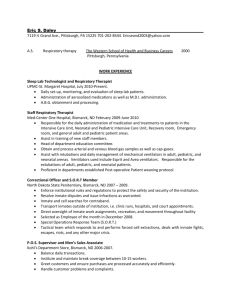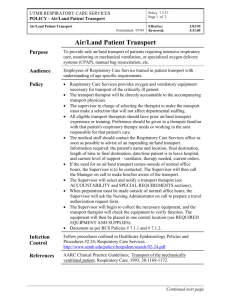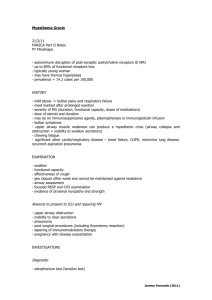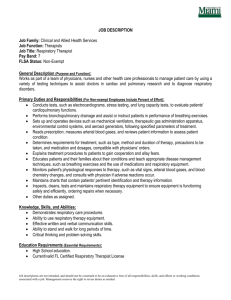Portable Oxygen Transport
advertisement
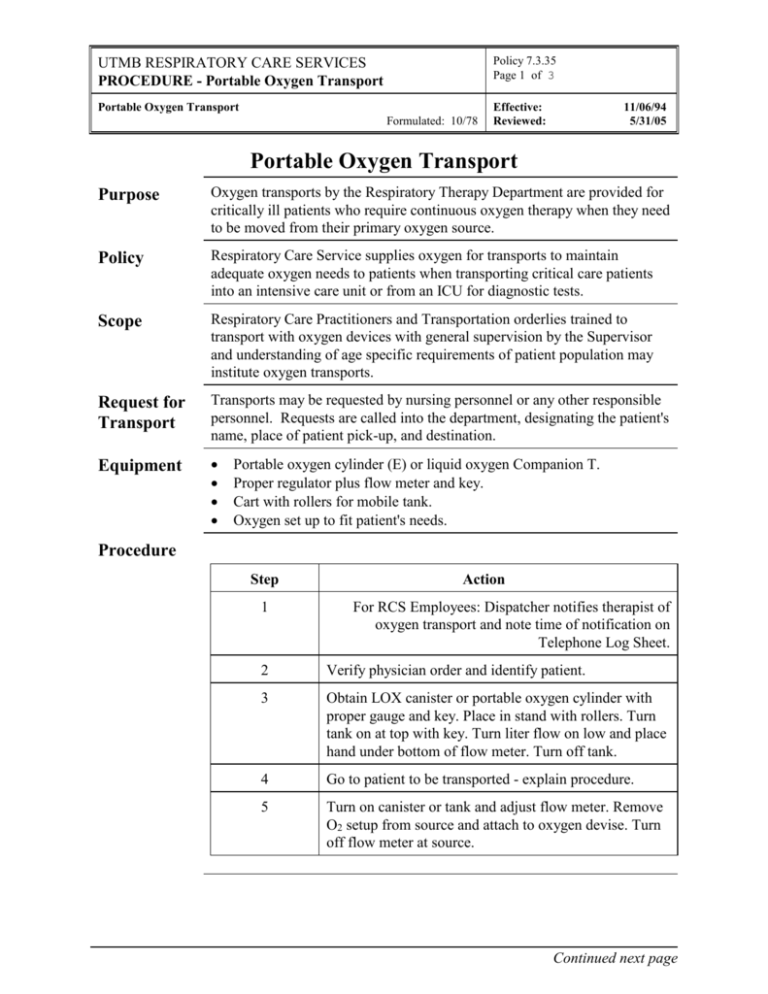
Policy 7.3.35 Page 1 of 3 UTMB RESPIRATORY CARE SERVICES PROCEDURE - Portable Oxygen Transport Portable Oxygen Transport Formulated: 10/78 Effective: Reviewed: 11/06/94 5/31/05 Portable Oxygen Transport Purpose Oxygen transports by the Respiratory Therapy Department are provided for critically ill patients who require continuous oxygen therapy when they need to be moved from their primary oxygen source. Policy Respiratory Care Service supplies oxygen for transports to maintain adequate oxygen needs to patients when transporting critical care patients into an intensive care unit or from an ICU for diagnostic tests. Scope Respiratory Care Practitioners and Transportation orderlies trained to transport with oxygen devices with general supervision by the Supervisor and understanding of age specific requirements of patient population may institute oxygen transports. Request for Transport Transports may be requested by nursing personnel or any other responsible personnel. Requests are called into the department, designating the patient's name, place of patient pick-up, and destination. Equipment Portable oxygen cylinder (E) or liquid oxygen Companion T. Proper regulator plus flow meter and key. Cart with rollers for mobile tank. Oxygen set up to fit patient's needs. Procedure Step 1 Action For RCS Employees: Dispatcher notifies therapist of oxygen transport and note time of notification on Telephone Log Sheet. 2 Verify physician order and identify patient. 3 Obtain LOX canister or portable oxygen cylinder with proper gauge and key. Place in stand with rollers. Turn tank on at top with key. Turn liter flow on low and place hand under bottom of flow meter. Turn off tank. 4 Go to patient to be transported - explain procedure. 5 Turn on canister or tank and adjust flow meter. Remove O2 setup from source and attach to oxygen devise. Turn off flow meter at source. Continued next page Policy 7.3.35 Page 2 of 3 UTMB RESPIRATORY CARE SERVICES PROCEDURE - Portable Oxygen Transport Portable Oxygen Transport Formulated: 10/78 Effective: Reviewed: 11/06/94 5/31/05 Procedure Continued Step Action 6 Transport patient safely (see safety standards) to destination. 7 If patient is to remain on transport cylinder any length of time and is on high flow O2, check to see if there is adequate amount of oxygen in cylinder to last required time. If not, replace tank with full one or an H-Cylinder with adequate supply. 8 If possible, change O2 setup to H cylinder or wall source and set flow meter at proper flow. Check regulator for adequate pressure and change tank as needed. 9 When patient is to return, repeat above steps. 10 Remind persons who are in the area of transports not to smoke. 11 When transport is complete, chart on RCS flow sheet date, time of transport, oxygen delivery device and FIO2, and destination of transport. Document transport on department treatment card. Transports out of ICU's: Includes patients on oxygen being transferred from an ICU to the floor or another ICU. Step Action 1 A patient on oxygen will be transported out of an ICU with a therapist/nurse/trained Transport technician being present. 2 It is the responsibility of the therapist assigned to the ICU to see that his/her patients are transported safely and provide coverage in the ICU. 3 If only one therapist is assigned to a unit, the therapist should notify the Supervisor. The Supervisor will then arrange for ICU coverage or the transport. Continued next page Policy 7.3.35 Page 3 of 3 UTMB RESPIRATORY CARE SERVICES PROCEDURE - Portable Oxygen Transport Portable Oxygen Transport Formulated: 10/78 Effective: Reviewed: 11/06/94 5/31/05 Procedure Continued 4 The therapist performing the transport is to notify the therapist assigned to the areas of the patient's new location. Make sure an oxygen flow meter is available for the set-up in the patient's new location. 5 Document as outlined in RCS Policies # 7.1.1 and # 7.1.2. Undesirable Side Effects Patients that are not ambulatory may experience distress when moved. Respiratory Care Service personnel must be aware of these signs such as dizziness, nausea, weakness, drop in blood pressure or rise in pulse and be prepared to act for the health of patients. If these signs occur, notify patient's nurse or physician of change in patient status. Ask if patient can be transported or moved. Patient Teaching Instruct the patient as follows: Explain to the patient why he is being moved. Reassure the patient that everything will be done to make the move as comfortable as possible and that his/her oxygen therapy will continue uninterrupted. Infection Control Follow procedures outlined in Healthcare Epidemiology Policies and Procedures #2.24; Respiratory Care Services. http://www.utmb.edu/policy/hcepidem/search/02-24.pdf References AARC Clinical Practice Guidelines; Respiratory Care; 2002: – 2002 Revision and Update; 47(7): 721-723 In-Hospital Transport of the Mechanically Ventilated Patient Palmon SC, Liu M, Moore LE, Kirsch JR. Capnography facilitates tight control of ventilation during transport. Critical Care Medicine, 1996; 24:608-611. Szem JW, Hydo LJ, Fischer E, Kapur S, Klemperer J, Barie PS. High-risk intrahospital transport of critically ill patients: safety and outcome of the necessary "road trip". Critical Care Medicine. 1995; 23:1660-1666. Stubbs CR, Crogan KJ, Pierson DJ. Interruption of oxygen therapy during intrahospital transport of non-ICU patients: elimination of a common problem through caregiver education. Respiratory Care. 1994; 39:968-972.
